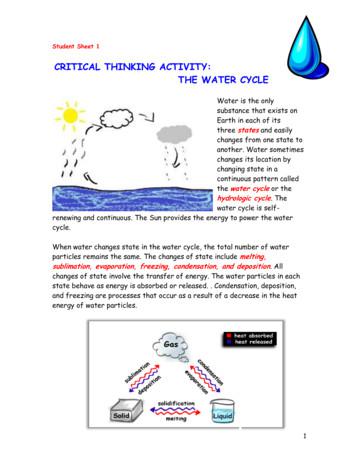Packet: Water Cycle
Name:Water and ClimateDate: Period:Earth SciencePacket: Water CycleCLASS NOTES Ever since the outgassing of water vapor years ago, Earth has beenits water supply Earth’s has not gained or lost water sinceThe Water Cycle - The water cycle is fueled by [insolation] and gravityEvaporation - Condensation - Transpiration - Precipitation - Examples: rain, snow, sleet and hailWhen precipitation falls it can: Be stored on land surfaces as ice and snow into the upper parts of the lithosphere Flow over Earth’s surface as Be or undergoLeigh-Manuell - 1
Packet: Water Cycle Infiltration - Factors Affecting Infiltration:1. Slope of the Land - steeper slopes do not give time for water to infiltrate the ground2. Degree of Saturation - the amount of water already in the ground3. Porosity -4. Permeability -5. Capillarity -6. Vegetation - plants absorb water from the groundLeigh-Manuell - 2
Packet: Water CyclePART I QUESTIONS: MULTIPLE CHOICEBase your answers to questions 1 through 3 on the diagram below, which shows a model of the watervapor cycle. Letters A through F represent some processes of the water cycle. Letter X indicates the topof the underground zone that is saturated with water.1. Which process is represented by letter F?a. capillarityb. infiltrationc. condensationd. vaporization2. What does letter X represent?a. the water tableb. a flood plainc. sea leveld. impermeable rock3. If the surface soil is saturated and precipitation increases, there will bea. a decrease in the amount of groundwaterb. a decrease in the surface elevation of the lakec. an increase in the rate of capillarityd. an increase in the amount of runoffLeigh-Manuell - 3
Packet: Water Cycle4. During a rainstorm, when soil becomes saturated, the amount of infiltrationa. decreases and runoff decreasesb. decreases and runoff increasesc. increases and runoff decreasesd. increases and runoff increases5. A paved blacktop parking lot was built on what was once a soil-covered field. This area will nowexperience increased runoff when rain occurs because the paved parking lot hasa. less capillarityb. greater infiltrationc. less permeabilityd. greater porosity6. Compared to an area with gentle slopes, an area with steeper slopes most likely hasa. less infiltration and more runoffb. less infiltration and less runoffc. more infiltration and more runoffd. more infiltration and less runoffBase your answers to questions 7 through 8 on the diagram below, which shows two identical containersfilled with uniform particles that were sorted by size.7. Which characteristic is most likely the same for these particle-filled containers?a. infiltration rateb. water retentionc. capillarityd. porosity8. Water will be able to infiltrate each of these sediment samples if the sediment is?a. saturated and impermeableb. saturated and permeablec. unsaturated and impermeabled. unsaturated and permeableLeigh-Manuell - 4
Packet: Water CyclePART II QUESTIONS: FREE RESPONSEBase your answers to questions 9 through 10 on the diagram below that represents a portion of a streamand its surrounding bedrock. The arrows represent the movement of water molecules by the processes ofthe water cycle. The water table is indicated by a dashed line. Letter A represents a water cycle process.Letter d represents the distance between the water table and the land surface.9. Identify water cycle process A, which produces cloud droplets.10. Describe the permeability, porosity and slope that allow the most infiltration of rainwater.Leigh-Manuell - 5
Packet: Water Cycle Leigh-Manuell - 3. 4. During a rainstorm, when soil becomes saturated, the amount of infiltration a. decreases and runoff decreases b. decreases and runoff increases c. increases and runoff decreases d. increases and runoff increases 5. A paved blacktop pa
Acme Packet 1100 Acme Packet 3900 Acme Packet 4600 front bezel hides the fan assemblies without restricting airflow through the system. Acme Acme Packet 6100 Acme Packet 6300 Packet 6300 Acme Packet 6350 The rear of Acme Packet 6300 least one slot reserved for an NIU.
Key Words Condensation, Diagram, Evaporation, Water Cycle Summary After seeing a demonstration of the water cycle (see lesson 3.F.1 The Water Cycle: Part 1), students will diagram and label the water cycle on their own. The students will also confirm that water expands when cooled. Learning Objectives 2002 Worcester Public Schools (WPS .
Water Cycle Poster Project You have been learning about the water cycle. The water cycle is continually changing from liquid water to water vapor to ice. One way to think about the water cycle is to follow a drop of water around as it moves on its way through the
Activity: The Water Cycle Time: 20 min. Learning objective: Investigate the water cycle to see how water is used on Planet Earth Resources: The Water Cycle worksheet Teacher’s notes Using the Water Cycle worksheet explain the water cycle using its technical terms. Students are then to label the picture with the technical terms. If time allows the
The Water Cycle Lexile Level: 1070 A The water cycle is a complex process that gives us water to drink, lakes for our fish to swim, and water for our crops to grow. About three-fourths of the Earth is covered in water. 97% of the water on Earth is salt water and about 3% of the Earth’s water is fresh. 2% of the Earth’s water is frozen in
THE WATER CYCLE Water is the only substance that exists on Earth in each of its three states and easily changes from one state to another. Water sometimes changes its location by changing state in a continuous pattern called the water cycle or the hydrologic cycle. The water cycle is self-renewing and continuous.
conditions to stages of the water cycle . Water Cycle Pretest 2 . Remembering the Water Cycle 3 Water Vapor Molecules . Stages of the Water Cycle are connected to atmospheric condition
9. Draw a replica of the blank STUDENT WORKSHEET: “Water Cycle Game” on the board or use the OVERHEAD: “Water Cycle.” Invite students to share the path they took. Compare students’ paths. 10. If needed, introduce the term “water cycle.” Explain that a cycle is something that repeats over and over. For example, the year is a cycle.























